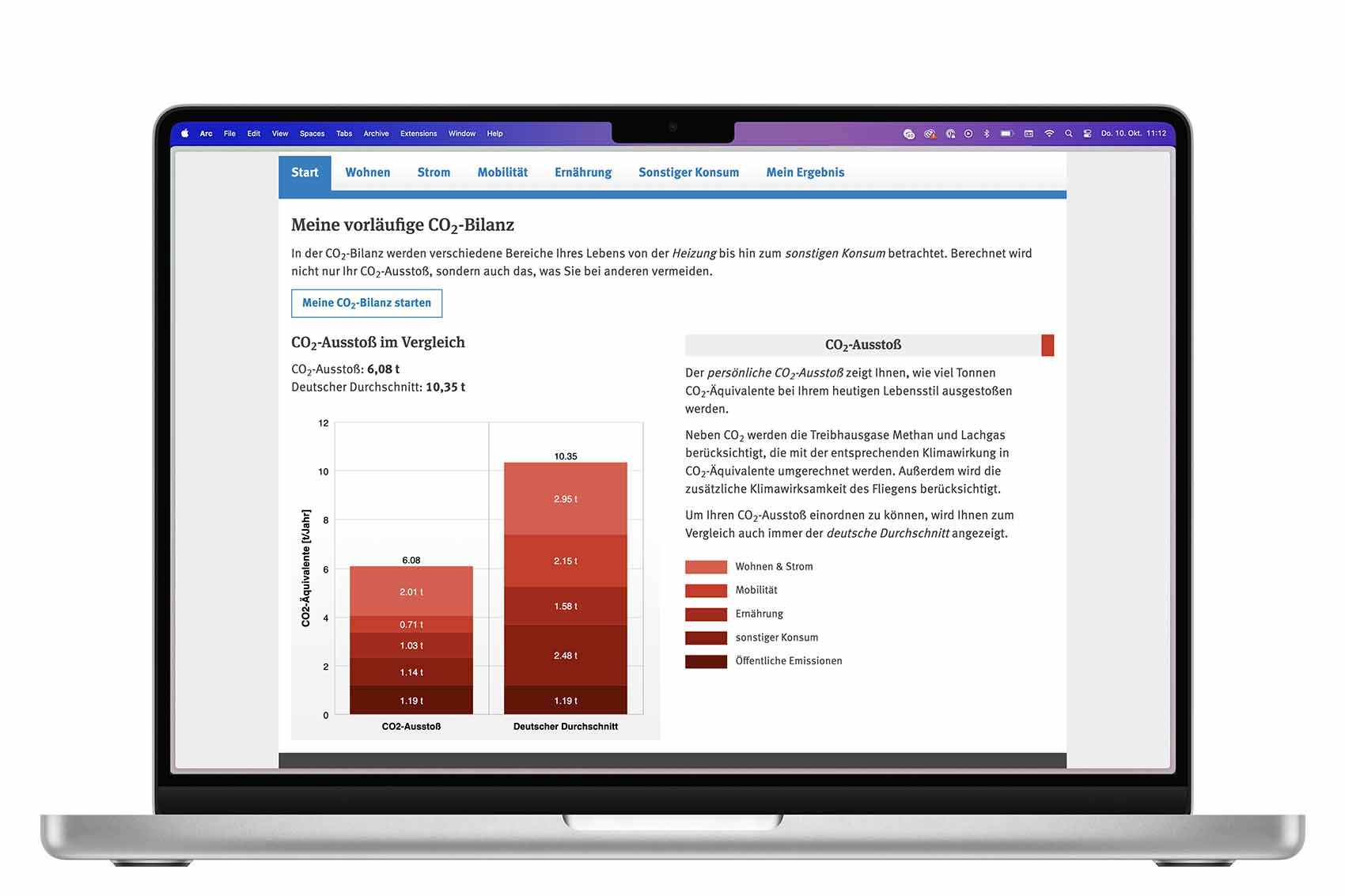Over the course of several years, researchers in Berlin looked at 100 households in Berlin. They wanted to see how people’s lives would change if they reduced their annual CO2 emissions by 30 just percent. Inspired by this pioneering study, the Klix³ initiative is now trying to extend this principle to the whole of Germany, and beyond.
<!–
window.CustomSubstackWidget = {
substackUrl: “https://digitalforgood.substack.com/”,
placeholder: “my email address”,
buttonText: “Subscribe”,
theme: “custom”,
colors: { primary: “#57B050”, input: “#000000”, email: “#FFFFFF”, text: “#000000”,
}
};
–>
Interested parties can register a free toolbox to determine their CO2 footprint. Klix³ then suggests practical measures that users can take to reduce it. All this is done using addictive gamification elements.
First step: Determine your own CO2 footprint using a questionnaire
In order to use the Klix³ toolbox, users must enter their postcode and some other personal data. They then answer a series of questions for the CO2 calculator, which was developed by the Federal Environment Agency.
The questions include lifestyle topics, such as daily or weekly meat consumption or your current living situation. Klix³ divides the information into the categories “Housing & electricity”, “Mobility”, “Food”, “Other consumption” and “Public emissions”. If you want a particularly detailed calculation of your own CO2 emissions, you can also upload your current gas or electricity bill.
We had to give it a go. In our example, the annual CO2 emissions of 6.08 tonnes are far below the German average of 10.35 tonnes per year. However, even this more climate-conscious lifestyle (no car, infrequent air travel and a vegetarian diet) leads to an environmental impact that exceeds the EU’s current climate recommendations. Gulp.
The Kyoto Plus⁴ initiative, for example, sets a target of five tonnes of emissions per capita per year. In order to achieve the Paris climate targets by 2050, per capita emissions would have to fall below a single tonne.
Gamification elements motivate people to save CO2
Klix³ uses the habits entered as the basis for creating a personalised climate plan. In this plan, the platform suggests various ways in which users can reduce their per capita emissions. As well as simple tips such as reducing the streaming quality on your next film night or switching to a water-saving shower head, Klix³ also lists “big points”. These reduce the carbon footprint more efficiently and in the long term, but also go hand in hand with a major changeover. For example, your own climate plan can also include not travelling by plane for the next 12 months. Holidays are of course still allowed – international train journeys are much more environmentally friendly than flights.
Users can mark the planned actions with “I’ll do it” and then tick them off with “I’ve done it”. In addition to the digital version of your own climate action plan, Klix³ also offers a printable version. This can be pinned to the fridge as a daily reminder.
Recording the carbon footprint and reducing one’s own footprint are the first two steps of a triad that the initiators of the project see as the basis for the toolbox. The third step is then about motivating other people about their own “handprint”.
For example, users are asked to share a “Big Point” with three people in their immediate vicinity. Links to social media are also conceivable – we have explored the extent to which social media such as Instagram or X can help motivate people to be more activist in the linked article.
Annual recording of the carbon footprint as part of a long-term study
The Klix³ toolbox is designed to motivate participants to reduce their own carbon footprint. However, it is not only interesting to see how many emissions your own everyday life causes. The data is also used for the first nationwide long-term study on the Federal Environment Agency’s CO2 calculator. The project is funded by the Federal Ministry for Economic Affairs and the Environment as part of the National Climate Protection Initiative.
At the same time, the project shows how the collection of data can be combined with practical tips for environmentally conscious everyday life. By allowing users to create an individual climate plan in the Klix³ toolbox, the initiators can also observe which measures are perceived as attractive and suitable for everyday use by participants.
If the Klix³ approach is as successful as the source of inspiration from Berlin, the effort will be well worth it. According to “Klimaneutral Leben in Berlin” (Climate-neutral living in Berlin), the organisers of the original Berlin experiment, participants reduced their CO2 emissions to an average of 7.3 tonnes per year. With a reduction of almost 40 percent compared to the German national average, the results are above the original target of 30 percent.
The post Calculate and Reduce CO2 Footprint: Klix³ Toolbox Motivates People to Protect the Climate Through Gamification appeared first on Digital for Good | RESET.ORG.


